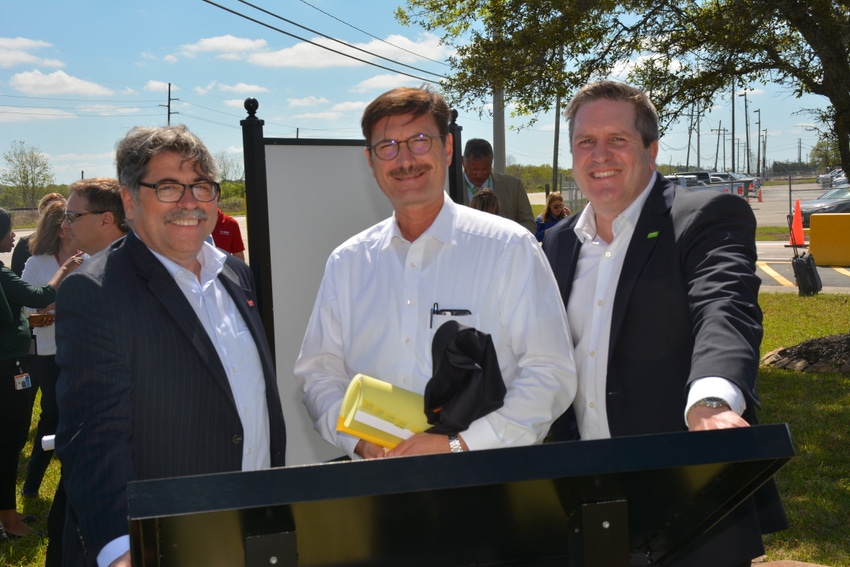March 22, 2017

National Agricultural Appreciation Day, March 21, was an appropriate opportunity for BASF to celebrate the expansion of its Beaumont, Texas, manufacturing plant, the U.S. facility that produces the company’s dicamba products, including the recently-labeled Engenia.
“An innovative spirit is in our DNA,” said Markus Heldt, president of BASF Crop Protection, in remarks prior to a ribbon cutting ceremony recognizing completion of the expansion project. “Innovation is important to BASF. We will continue to bring innovative solutions to agriculture around the globe.”
Heldt says Engenia represents the company’s commitment to innovation. Dicamba has been around for 50 years, but with the growing challenge of controlling herbicide-resistant weed species, especially those resistant to glyphosate and other herbicides, farmers need new technology to remain profitable.
Engenia, in combination with dicamba-tolerant cotton and soybean varieties, “offers a new tool, and is an example of how to bring innovation to farmers.”
He says a new salt molecule in Engenia reduces volatility, limiting the possibility of off-target movement and improving efficiency.
Paul Rea, senior vice president, BASF Crop Protection North America, says the resistant weed challenges put pressure on companies, farmers and advisors to come up with effective methods to control weeds.
“In a 10-year period, the number of weeds resistant to glyphosate increased from 10 to 35,” Rea says. “Weed pressure could mean a 50-percent reduction in yield in cotton and soybeans, and resistant pigweed has emerged as a significant issue. BASF is leading the charge.”
FLEXIBLE DICAMBA PRODUCT
He says Engenia is the most responsive and most flexible dicamba product available for cotton and soybeans and will play a key role in managing resistance.
Peter Gress, senior vice president, global operations, BASF Crop Protection, says the Beaumont plant is “the home for dicamba in the United Sates.”
Rea adds that it is the only dicamba facility “up and running,” in the country.
Gress says the expansion took place in two stages over three years and increased dicamba production capacity by 50 percent. The expansion, a $270-million project, represents “the largest agricultural products facility investment in company history.”
In a Farm Press interview following the ribbon cutting, Heldt said ag manufacturing will be challenged to produce new technology in the coming years to meet the increased demand for food and fiber. With a global population expected to exceed 9.3 billion within 30 years, farmers will have to produce more food on fewer acres and with less water.
“We will need to produce 30 percent more products and increase availability by 70 percent,” Heldt noted.
Rea says agriculture will demand more new products than just improved dicamba. “Product stewardship is important.” The growing number of weeds resistant to glyphosate proves the point. “We have to protect the technology, so we will need to invest more money in research and development to find new products.”
R&D INVESTMENT
That poses significant challenges. “In 1998, it took an ag manufacturing company $150 million to develop a new product. In 2012, that figure was $286 million,” Rea says.
And it’s not just an investment in money, Heldt adds. “In 1998, we produced a new product—from start to market—in eight years. It takes 11 or 12 now.”
He adds that BASF did not throw in the towel when much of the industry thought glyphosate-tolerant plants were “the be-all and end-all,” for weed control. “We continued our investment in R&D. We will continue to look for products and in 10 or 15 years we will see what we have.”
Rea says BASF has put some new molecules in the market in the past few years but new modes of action are needed.
Heldt, Rea and Gress also emphasize the significance of product stewardship and sustainable agriculture. Recently, BASF offered training opportunities for growers, advisors and consultants to learn how to manage and apply products effectively, efficiently and safely through the “On Target Application Academy (OTAA), which provides extensive training that promotes correct and effective herbicide application.”
“We have trained more than 15,000 through our stewardship program,” Rea says.
Although no other single facility comes close to the $270 million in capital improvements made at Beaumont, BASF has recently invested $290 million in other plants, including facilities in Sparks, Ga., and Hannibal, Mo.
Matt Huie, a Beeville, Texas, farmer and rancher, addressed the assembled BASF employees, local dignitaries and farm association representatives, by explaining the challenges farmers face daily with “drought, wind, low prices, high costs and short labor.
“So we rely on technology—plants and chemistry—to produce efficiently,” he says. “Roundup Ready crops made farming easier, but a combination of over use, below rate use and Mother Nature, created resistance. Roundup is still useful, but it is no longer a one-stop fix.”
He adds that Mother Nature likely will produce more resistant weeds in the future, making innovation essential to provide effective crop protection products to farmers.
Even with low commodity prices farmers must strive for good yields. “The only way we can achieve that is with clean fields, and to get that we have to use multiple modes of action.”
He concluded with a thank you to BASF employees. “Farmers appreciate what you do.”
You May Also Like




